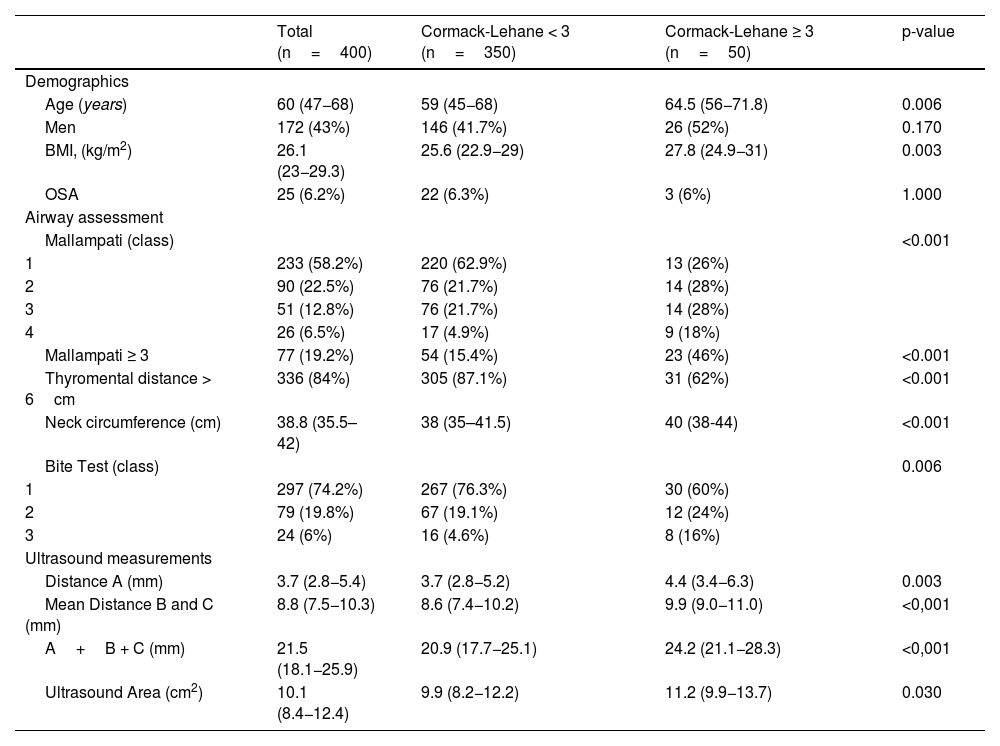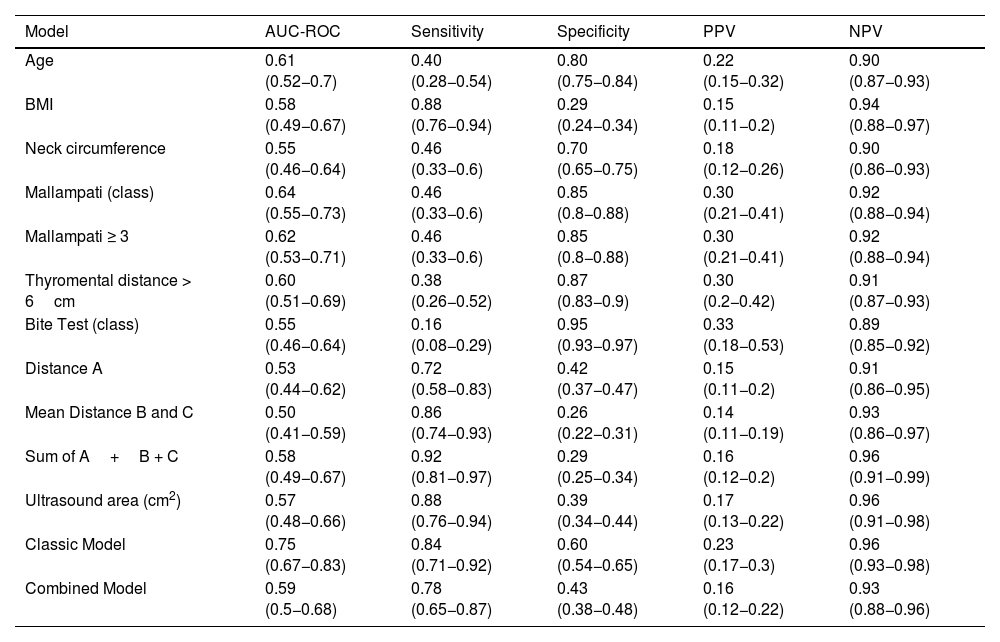To demonstrate the utility of machine learning models for predicting difficult airways using clinical and ultrasound parameters.
MethodsThis is a prospective non-consecutive cohort of patients undergoing elective surgery. We collected as predictor variables age, sex, BMI, OSA, Mallampatti, thyromental distance, bite test, cervical circumference, cervical ultrasound measurements, and Cormack-Lehanne class after laryngoscopy. We univariate analyzed the relationship of the predictor variables with the Cormack-Lehanne class to design machine learning models by applying the random forest technique with each predictor variable separately and in combination. We found each design's AUC-ROC, sensitivity, specificity, and positive and negative predictive values.
ResultsWe recruited 400 patients. Cormack-Lehanne patients≥III had higher age, BMI, cervical circumference, Mallampati class membership≥III, and bite test≥II and their ultrasound measurements were significantly higher. Machine learning models based on physical examination obtained better AUC-ROC values than ultrasound measurements but without reaching statistical significance. The combination of physical variables that we call the “Classic Model” achieved the highest AUC-ROC value among all the models [0.75 (0.67−0.83)], this difference being statistically significant compared to the rest of the ultrasound models.
ConclusionsThe use of machine learning models for diagnosing VAD is a real possibility, although it is still in a very preliminary stage of development.
Clinical registryClinicalTrials.gov: NCT04816435.
Demostrar la utilidad de modelos de aprendizaje automático para la predicción de vía aérea difícil mediante el uso de parámetros clínicos y ecográficos.
MétodosSe trata de una cohorte prospectiva no consecutiva de pacientes sometidos a cirugía electiva. Se recogieron la edad, el sexo, el IMC, la presencia de SAOS, el grado en la escala Mallampati, la distancia tiromentoniana, la clase en el test de la mordida, la circunferencia cervical, las mediciones ecográficas cervicales y el grado en la clasificación de Cormack-Lehanne tras laringoscopia directa. Se analizó de forma univariante la relación de las variables predictivas con la clasificación Cormack-Lehanne para diseñar modelos de aprendizaje automático aplicando la técnica de random forest. Para cada diseño se calculó: AUC-ROC, sensibilidad, especificidad y valores predictivos positivos y negativos.
ResultadosSe reclutaron 400 pacientes. En el análisis se evidenció que aquellos pacientes Cormack-Lehanne≥III tenían mayor edad, IMC, circunferencia cervical, mayor clase en el test Mallampati y de la mordida. Además las mediciones ecográficas fueron significativamente mayores en los pacientes Cormack-Lehane≥III. Se objetivó que los modelos de aprendizaje automático basados en la exploración física obtuvieron mejores valores de AUC-ROC que los basados en mediciones ecográficas, sin alcanzar significación estadística. La combinación de variables físicas al que se denominó “Modelo Clásico” alcanzó el mayor valor de AUC-ROC de entre todos los modelos [0.75 (0.67−0.83)] siendo esta diferencia estadísticamente significativa frente al resto de modelos ecográficos.
ConclusionesLa utilización de modelos de aprendizaje automático para el diagnóstico de VAD es una posibilidad real, aunque todavía está en una fase muy preliminar de desarrollo.
RegistroclínicoClinicalTrials.gov: NCT04816435.










